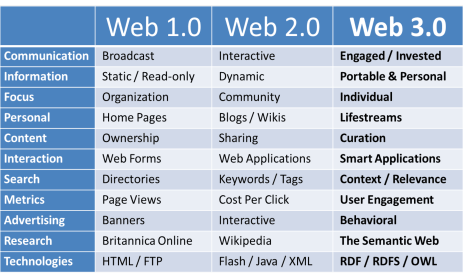Future of the Web[]
Some Internet experts believe that the web is gravitating towards the next generation of the Web, {{ #NewWindowLink: http://www.slideshare.net/ghazalhina/detail-history-of-web-10-to-30 | Web 3.0 }}. Also referred to as {{ #NewWindowLink: http://semanticweb.org | "The Semantic Web" }},{{ #NewWindowLink: http://www.slideshare.net/ghazalhina/detail-history-of-web-10-to-30 | Web 3.0 }} is predicted to solve many of the problems that users experience when browsing the Internet.
The semantic web is looking to make inferences about the relationships between data so that relevant information can more easily be brought to the user.[1] This is done using ‘vocabularies’ or ‘ontologies,’ which will define the set of rules needed to make the data relatable. Additionally, the coming of “Query” technology will assist in the swift retrieval of Web data. The development of SPARQL Protocol and RDF Query Language({{ #NewWindowLink: http://en.wikipedia.org/wiki/SPARQL | SPARQL }}) would allow for the sending of queries, as well as the receiving of results through existing protocols, such as Hypertext Transfer Protocol ({{ #NewWindowLink: http://en.wikipedia.org/wiki/HTTP | HTTP}}) or Simple Object Access Protocol ({{ #NewWindowLink: http://en.wikipedia.org/wiki/SOAP | SOAP }}).
Web 3.0 could be defined as, "a phrase coined by John Markoff of the New York Times in 2006, [which] refers to a supposed third generation of Internet-based services that collectively comprise what might be called ‘the intelligent Web’ — such as those using {{ #NewWindowLink: http://semanticweb.org | semantic web }}, {{ #NewWindowLink: http://microformats.org | microformats }}, {{ #NewWindowLink: http://www.networkcomputing.com/1120/1120f1side2.html?ls=NCJS_1120rt | natural language search }}, {{ #NewWindowLink: http://www.anderson.ucla.edu/faculty/jason.frand/teacher/technologies/palace/datamining.htm | data mining }}, {{ #NewWindowLink: http://alex.smola.org/drafts/thebook.pdf | machine learning }}, {{ #NewWindowLink: http://opim.wharton.upenn.edu/~kartikh/reading/ib1.pdf | recommendation agents }}, and {{ #NewWindowLink: http://www-formal.stanford.edu/jmc/whatisai/whatisai.html | artificial intelligence }} technologies — which emphasize machine-facilitated understanding of information in order to provide a more productive and intuitive user experience.” Web 3.0 can also be though of as a third-generation of the Web enabled by the convergence of several key emerging technology trends:[2]
- Ubiquitous Connectivity
- Broadband adoption
- Mobile Internet access
- Mobile devices
- Network Computing
- Software-as-a-service business models
- Web services interoperability
- Distributed computing ({{ #NewWindowLink: http://en.wikipedia.org/wiki/Peer-to-peer | P2P }}, grid computing, hosted "cloud computing" server farms such as {{ #NewWindowLink: http://en.wikipedia.org/wiki/Amazon_S3 | Amazon S3 }})
- Open Technologies
- Open APIs and protocols
- Open data formats
- Open-source software platforms
- {{ #NewWindowLink: http://en.wikipedia.org/wiki/Open_Data | Open data }} (Creative Commons, Open Data License, etc.)
- Open Identity
- Open identity (OpenID)
- Open reputation
- Portable identity and personal data (for example, the ability to transport user accounts and search history from one service to another)
- The Intelligent Web
- Semantic Web technologies ({{ #NewWindowLink: http://en.wikipedia.org/wiki/Resource_Description_Framework | RDF }}, {{ #NewWindowLink: http://en.wikipedia.org/wiki/Web_Ontology_Language | OWL }}, {{ #NewWindowLink: http://www.w3.org/Submission/SWRL/ | SWRL }}, {{ #NewWindowLink: http://en.wikipedia.org/wiki/SPARQL | SPARQL }}, Semantic application platforms, and statement-based datastores such as {{ #NewWindowLink: http://www.w3.org/2001/sw/Europe/events/20031113-storage/positions/rusher.html | triplestores }}, {{ #NewWindowLink: http://www.erlang.org/ml-archive/erlang-questions/200606/msg00335.html | tuplestores }} and associative databases)
- Distributed databases - or what is called "The World Wide Database" (wide-area distributed database interoperability enabled by Semantic Web technologies)
- Intelligent applications (natural language processing, machine learning, machine reasoning, autonomous agents)
Relating data would be useful in the healthcare field.[1] Doctors and hospital staff have information about patients, diagnoses, diseases, symptoms, treatment plans and other clinical data. Separately, pharmaceutical companies have information about drugs, dosages, allergies, side-effects, and costs. With the semantic Web, combining this data and streamlining it to apply to individual patients would allow for intelligent applications, such as drug efficiency, tools for helping with medical decisions, and a database of feedback to further epidemiological research.
Beyond Web 3.0[]
The Web will likely be applicable in a three-dimensional environment. Rather than {{ #NewWindowLink: http://www.slideshare.net/ghazalhina/detail-history-of-web-10-to-30 | Web 3.0 }}, there may be a Web 3D. Combining virtual reality elements with the persistent online worlds of massively multiplayer online roleplaying games {{ #NewWindowLink: http://www.mmorpg.com | (MMORPGs) }}, the Web could become a digital landscape that incorporates the illusion of depth. Users would navigate the Web either from a first-person perspective or through a digital representation of oneself called an Avatar.
The Web will build on developments in distributed computing and lead to true {{ #NewWindowLink: http://www-formal.stanford.edu/jmc/whatisai/whatisai.html | artificial intelligence }}. In {{ #NewWindowLink: http://publib.boulder.ibm.com/infocenter/txformp/v6r0m0/index.jsp?topic=%2Fcom.ibm.cics.te.doc%2Ferziaz0015.htm | distributed computing }}, several computers tackle a large processing job. Each computer handles a small part of the overall task. Some people believe the Web will be able to think by distributing the workload across thousands of computers and referencing deep {{ #NewWindowLink: http://www-ksl.stanford.edu/kst/what-is-an-ontology.html | ontologies }}. The Web could become analogous to a giant brain capable of analyzing data and extrapolating new ideas based off of that information.
The Web will extend far beyond computers and cell phones. Everything from watches to television sets to clothing will connect to the Internet. Users will have a constant connection to the Web, and vice versa. Each user's software agent will learn more about its respective user by electronically observing his or her activities. Utilizing the Web in this manner may spark debates about the balance between Individual Privacy and the Benefits of having a personalized Web browsing experience. The Web will merge with other forms of entertainment until all distinctions between the forms of media are lost. Radio programs, television shows and feature films will rely on the Web as a delivery system.
Citations[]
- ↑ 1.0 1.1 W3C. (2013). Semantic web. World Wide Web Consortium. Retrieved from {{ #NewWindowLink: http://www.w3.org/standards/semanticweb }}
- ↑ Antoniou, G., & Harmelen, F.(2008) A Semantic Web Primer (2nd ed.). Cambridge, Mass: MIT Press.
